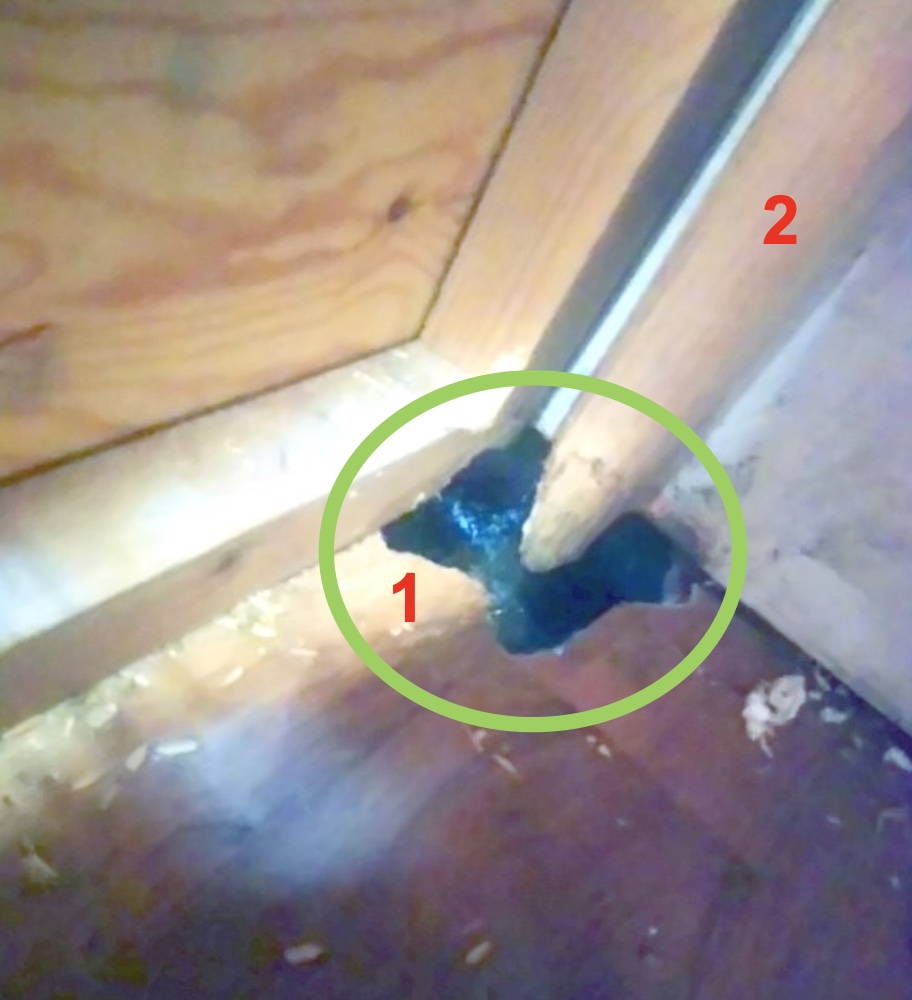All fanciers have unwanted trials of various kinds, and if you keep mice for long enough you are likely to encounter every known issue at some point.This year’s problem for Smith & Hollis has been a wild rat, or more than one rat, and I know we are not the only ones to suffer. We have had occasional visitors for years, but there seems to have been something of an epidemic this year, all over the country.The rats have made two holes in the back of my shed, the one pictured (1, the circled irregular black area) and another further along of similar size. They started out as mouse holes, years ago, gradually enlarged by the rats. The tapering upright (2) is part of the frame of the shed, which has been chewed to that shape. It protrudes a couple of inches below the level of thefloor, so it is not just a case of covering the hole as there would need to be something unchewable cut to fit around the upright. It is also fairly inaccessible from outside as the back wall of the shed goes down lower than the floor.These holes are difficult to get to, being underneath and behind the racks holding the boxes, so scrabbling on the floor is a requirement when dealing with them.

Rat holes (Photo: Ruth Hollis)
The first incursions of the rat were mild, I only knew it was coming in because it ripped a hole in the bag of cleanings out on the floor, and left a few droppings. But within a few days it was more adventurous and started visiting the tops of the mouse boxes. Each morning I shifted bricks around over the holes. I bought two rat-poison stations and put one outside the shed and one inside. The rat was not interested in the poison blocks, a couple of small nibbles and that was that. One hole I stopped by cutting a piece out of a plastic lid from a cake box so it was quite flat, then wedging it against the wall with a large square terracotta plant pot weighting it down. That seemed to work, but the other hole (pictured) got bigger. I stuffed it with ever more obstacles. One was a leather gardening glove filled with gravel,Pest Control21fingers as well. Though it bit away a lot of the fingers, the rat was thwarted by the gravel. Instead, it made the wooden hole bigger.Stuart’s shed is a bitdifferent in design,also with two ratholes. The one atthe back is in thewall, so an edifice ofbricks on top of apoison station(black plastic boxwith holes in either end) has stopped it up. The main rat entrance, however, is in the floor of the shed, near the front, where the electricity cable comes in. Gravel-filled glove weighted down by a brick is working at the moment, but before that the poison was also consumed, so which deterrent it was, is anybody’s guess.At the same time as the holestopping, when the rat started biting the mice’s feet and noses I stepped up the retaliation. Taking advice from a fancier friend, I put down some mouse food on thetire lot of food and poison had gone. This happened for several nights but the rat kept visiting both sheds.Finally, after the biggest effort yet to stop up the hole, the rat either gave up or succumbed to the poison—I suspect it was that. So far we have had nearly a week clearof visits.I don’t have anything against rats for themselves, they’re just part of our coexistence with nature, but I do get cross when my captive mice are attacked with no chance of escape: they are not going to cower at the back of the box, they’re going to fight the intruderthrough the wires.On the plus side, I discovered that covering the tops of the boxes was well received by the mice in that they have made far less mess on the floor, caused by them trying to block up the front ventilation to prevent the draught going through the box. Everycloud has a silver lining!floor, which the rat ate. cardboard over the ventilation wire on the box tops, which I had to rearrange each morning. And I bought some rat poison.I mixed the poison with the mouse food after a couple of days and put it down inside a plastic ring, thinking I would be able to tell if the rat had touched it. Next morning, the en-I putHopefully my experiences will be useful to others facing a similar onslaught. I would be interested to hear of your approach if you have also had a rat prob-lem this winter.Ruth Hollis
 We use cookies to ensure that we give you the best experience on our website. If you continue to use this site we will assume that you are happy with it.
We use cookies to ensure that we give you the best experience on our website. If you continue to use this site we will assume that you are happy with it.
0 Comments